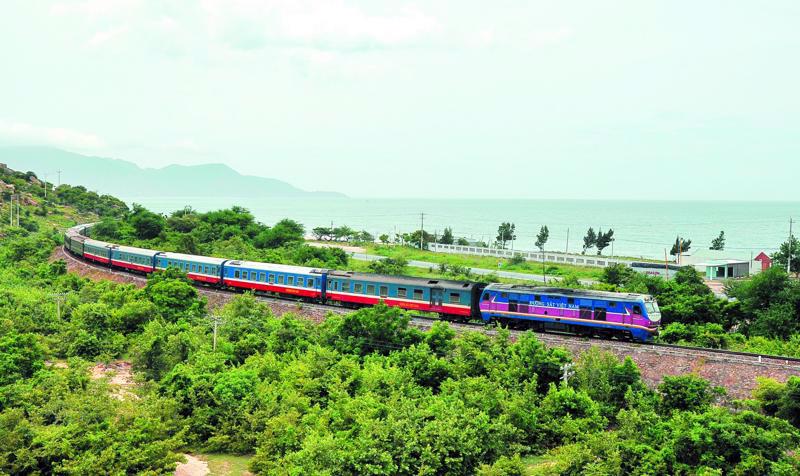Once a source of national pride, Vietnam’s railway industry has steadily lost ground due to aging infrastructure and poor connectivity. In recent years, however, the Party and the government have intensified efforts to breathe new life into the industry, rolling out ambitious strategies to gradually rebuild and modernize the railway network.
Despite these initiatives, railway transport still holds a modest market share in Vietnam’s transportation sector. According to the National Statistics Office (now under the Ministry of Finance), since 2019, passenger rail transport has never exceeded 0.17 per cent market share. The impact of Covid-19 in 2021 pushed this figure even lower, to just 0.06 per cent. On the freight side, railway transport saw its highest market share in 2021, of 0.35 per cent, but by 2024 this had fallen to just 0.19 per cent, highlighting the ongoing challenges the industry faces.
Improving connectivity
The decline in railway market share stems from multiple factors. One of the most significant is Vietnam’s outdated railway infrastructure. The country still primarily relies on a 1,000 mm gauge system that has been in place for more than a century. Despite ongoing efforts to upgrade and improve service quality, the railway network struggles to meet modern transportation demand, especially when neighboring countries have already adopted the 1,435 mm gauge. This disparity directly affects Vietnam’s railway connectivity, making it difficult for domestic freight transport to integrate with international rail networks.
Within the country, the lack of interconnectivity is even more evident, as the railway network remains largely disconnected from other modes of transportation such as aviation and waterway. This limitation reduces the railway’s role in the logistics chain, preventing it from maximizing its advantages. As a result, many transportation businesses still view rail as a secondary option despite its potential benefits.
With Vietnam’s economy targeting an annual growth rate of over 8 per cent, the development of transport infrastructure and the restructuring of transportation modes have become urgent priorities. The railway sector, in particular, needs to be recognized as a key pillar in reducing pressure on road networks and optimizing the country’s multimodal transport network.
To address these challenges, the government has introduced a Master Plan on the Railway Network for the 2021-2030 Period, with a Vision towards 2050, which focuses on selective development, prioritizing investments in key transport corridors with high demand while making full use of the existing network. It also outlines the construction of modern and well-integrated railway lines that connect seamlessly with seaports, airports, and major economic hubs.
A crucial aspect of this strategy is mobilizing capital from various economic sectors rather than relying solely on the State budget. While public investment will be directed towards building and upgrading railway infrastructure, the private sector is encouraged to participate in manufacturing locomotives and carriages, developing logistics services, and operating transportation systems.
The government is also aiming to establish a modern railway industry capable of maintaining self-sufficiency in equipment production and maintenance while promoting international cooperation to secure technology transfer. The plan emphasizes the application of Industry 4.0 advancements to optimize energy use, reduce environmental pollution, and enhance operational efficiency, ultimately transforming rail transport into a more intelligent and sustainable mode of transportation.
Back on track
Between now and 2030, the primary focus will be on renovating and upgrading the existing railway network while preparing for new routes. Efforts will be made to enhance safety and operational capacity across seven major railway lines, alongside investments in two high-speed rail sections on the North-South corridor. The government has also prioritized the development of railway connections to major seaports, including in Hai Phong in the north and in Ba Ria-Vung Tau in the south, as well as expanding rail links to international airports and key logistics hubs.
Looking ahead to 2050, the government aims to complete the North-South high-speed railway while continuing to expand railway networks connecting seaports, industrial parks, economic centers, and even the central highlands region.
The National Assembly recently approved several key resolutions that together mark a major shift for Vietnam’s railway sector. One of the most significant projects, the North-South high-speed railway line, has estimated investment of over VND1,713 trillion ($67 billion), while the Lao Cai-Hanoi-Hai Phong railway project is set to receive approximately VND203 trillion ($8.37 billion).
Resolution No. 188/2025/QH15, dated February 19, 2025, also introduces special mechanisms and policies to accelerate the development of urban rail networks in Hanoi and Ho Chi Minh City. Under the Resolution, during the 2026-2030 and 2031-2035 periods, the State budget will provide targeted financial support, with a maximum allocation of VND215.35 trillion ($8.3 billion) for Hanoi and VND209.5 trillion ($8.1 billion) for Ho Chi Minh City.
With these ambitious plans and strategic investments, Vietnam’s railway sector is set to undergo a significant transformation, playing a more prominent role in the country’s transportation and logistics landscape.
Seeking self-sufficiency
Vietnam is making comprehensive preparations to achieve a breakthrough in railway development, not only to enhance transportation infrastructure but also to create a vast market for the production of materials, equipment, and construction in the railway industry.
According to Mr. Tran Thien Canh, Director of the Vietnam Railway Authority, there is a significant demand for railway technology products. Specifically, the railway infrastructure construction sector requires 28.7 million meters of rail, 11,680 sets of switches, and 46 million sleepers.
From now to 2030, the railway sector will need an additional 15 locomotives and 26 narrow-gauge (1,000 mm) carriages, along with 250 locomotives and 1,760 standard-gauge (1,435 mm) carriages. By 2045, these numbers will increase substantially, reaching 150 locomotives and 160 narrow-gauge carriages as well as 2,000 locomotives and 10,144 standard-gauge carriages.
In terms of development strategy, by 2030, Vietnam aims to establish the capability to design locomotives and carriages through technology transfer, assembly, and the gradual localization of locomotives operating at speeds under 200 km/h. The railway sector also targets full domestic production of freight and passenger carriages with speeds under 120 km/h, achieving an 80 per cent localization rate. Notably, mastering the technology for manufacturing freight and passenger carriages under 200 km/h has been identified as a key priority.
Beyond rolling stock, the railway sector also aims to independently handle 90 to 95 per cent of the construction techniques for substructures and fully master the design and construction of superstructures for railway lines operating at speeds under 200 km/h. For high-speed rail, Vietnam seeks to participate in 50 to 70 per cent of the construction process, gradually enhancing its expertise in modern railway infrastructure development.
The production of railway materials and equipment is also being prioritized. The domestic metallurgical industry will focus on manufacturing P43 and P50 rails to international standard while mastering the maintenance and replacement of materials and spare parts for standard-gauge railways, urban railways, and high-speed rail.
Vietnam also aims to localize approximately 80 per cent of the power supply networks for locomotives and high-speed rail carriages, progressing towards full mastery of operations, maintenance, and spare part production.
With an ambitious vision for railway development, Vietnam is actively working towards self-sufficiency in vehicle manufacturing technology. By 2050, the country aims to fully master the design, construction, and operation of its railway network, including high-speed urban rail. Furthermore, acquiring and mastering railway signaling and communication technology is another crucial goal. Vietnam seeks to domestically produce 80 to 90 per cent of hardware components while fully developing software for communication and signaling systems.
Looking ahead to 2050, Vietnam’s vision is not only to build a modern railway network but also to take full control of all related technologies, from manufacturing rails and switches to international standards to self-sufficiency in railway electrification. With localization rates projected to reach 60 to 70 per cent across multiple sectors, the railway industry has a tremendous opportunity to rise and become a key pillar of the national economy.
|
* By 2030, the railway sector is expected to transport 11.8 million tons of cargo annually, accounting for 0.27 per cent of the total freight market, and carry 460 million passengers, equivalent to a 4.4 per cent market share * Freight transport turnover is estimated at 7.35 billion ton-kilometers, making up 1.38 per cent of the market, while passenger turnover is expected to hit 13.8 billion passenger-kilometers, capturing 3.55 per cent of the market. |









 Google translate
Google translate